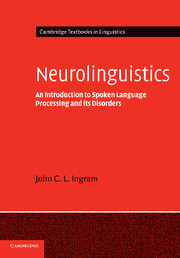Book contents
- Frontmatter
- Contents
- List of figures
- List of tables
- Preface and acknowledgements
- Note on the text
- Part I Foundational concepts and issues
- Part II Speech perception and auditory processing
- Part III Lexical semantics
- Part IV Sentence comprehension
- Part V Discourse: language comprehension in context
- 15 Discourse processing
- 16 Breakdown of discourse
- 17 Conclusion and prospectus
- Glossary
- References
- Index
17 - Conclusion and prospectus
Published online by Cambridge University Press: 26 January 2010
- Frontmatter
- Contents
- List of figures
- List of tables
- Preface and acknowledgements
- Note on the text
- Part I Foundational concepts and issues
- Part II Speech perception and auditory processing
- Part III Lexical semantics
- Part IV Sentence comprehension
- Part V Discourse: language comprehension in context
- 15 Discourse processing
- 16 Breakdown of discourse
- 17 Conclusion and prospectus
- Glossary
- References
- Index
Summary
Introduction
One of the small compensations afforded science writers over novelists, for the arduous obligation of eternal vigilance to potential counter-evidence whilst seeking ‘the best theory’, is that their stories do not require, and indeed are not expected to have, an ending, happy or otherwise. However, it is appropriate at this point to cast an eye over the broad canvas and ask where this inquiry has led us, what roadblocks stand in the way of further progress and what leading ideas appear to point the way ahead.
While it would be an exaggeration to label it a paradigm change, in recent years there has been a discernible shift in the leading metaphor employed in thinking about language in relation to brain function, away from the ‘mentalese’ of digital computational analogies towards what has been dubbed embodied cognition (Lakoff and Johnson, 1999; Garbarini and Adenzato, 2004), a conceptual shift that has been promoted by recent neurophysiological findings (such as the discovery of the mirror neuron system), by neuropsychological insights into the nature of acquired cognitive disabilities and the interconnected nature of cognitive skills and language abilities, and by attempts to re-conceptualize – in a more ‘biologically friendly’ or plausible manner – the nature of mental computation itself, inspired partly by connectionist modelling and partly by disillusionment with the empty rhetoric of the digital computational analogy of mind and the unfulfilled promises of high-end artificial intelligence. We shall unpack this outrageously overlong sentence presently.
- Type
- Chapter
- Information
- NeurolinguisticsAn Introduction to Spoken Language Processing and its Disorders, pp. 367 - 379Publisher: Cambridge University PressPrint publication year: 2007



